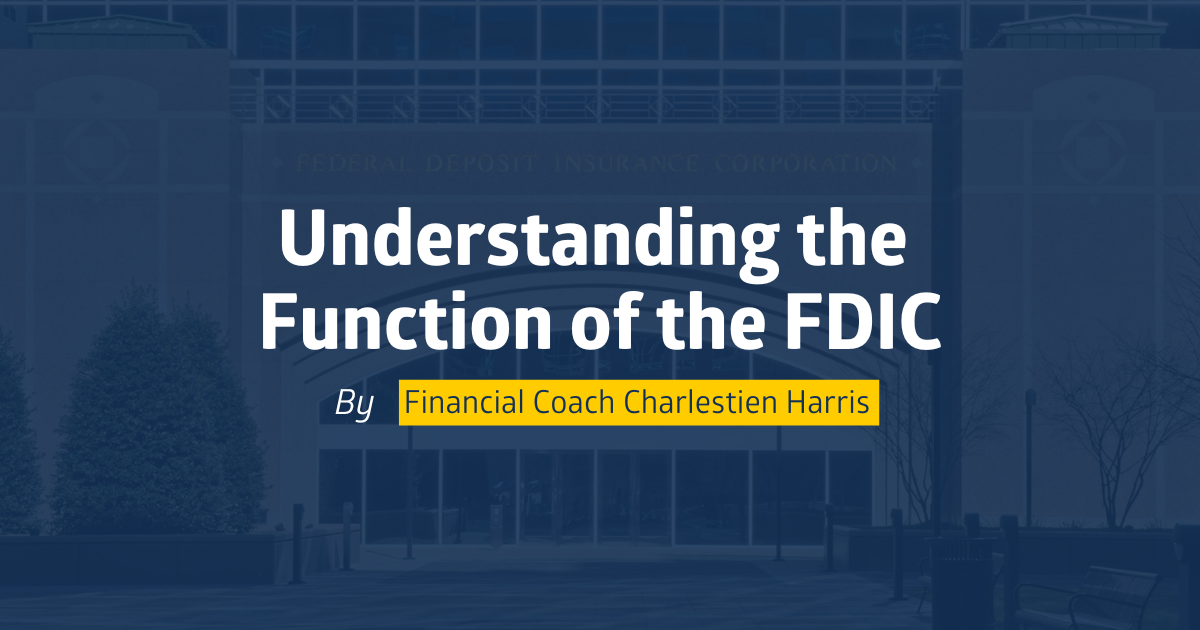By Charlestien Harris
If you’ve been following the national banking news lately, you’ve probably heard a lot of talk about FDIC insurance, and you might even be wondering about your own deposits. To answer some of those questions, my article this month will take a somewhat deep dive into what the FDIC is, how it protects your money, and how you can rest assured knowing your money is safe in your bank.
The FDIC is an independent agency created by the U.S. Congress to maintain stability and public confidence in the nation’s financial system. The FDIC insures deposits; examines and supervises financial institutions for safety, soundness, and consumer protection; makes large and complex financial institutions resolvable; and manages receiverships.
In addition to providing deposit insurance, the FDIC supervises and examines banks and savings associations across the country to make sure they’re operating soundly. The FDIC serves as the primary federal regulatory agency for banks that are chartered by states but not part of the Federal Reserve System. It’s also the FDIC’s responsibility to ensure banks comply with consumer protection laws, including the Fair Credit Billing Act, the Truth in Lending Act and the Fair Debt Collection Practices Act. The FDIC is headquartered in Washington, D.C., and is managed by a board of directors that includes members of the Office of the Comptroller of the Currency and the Consumer Financial Protection Bureau.
Here are five facts that you should know about the Federal Deposit Insurance Corporation.
1. FDIC insurance is how your money is protected. The standard insurance amount is $250,000 per depositor, per account ownership type, per financial institution. Consumers don’t have to do anything to take advantage of this coverage. If you have deposits at an FDIC member bank, you’re automatically covered. Banks and financial institutions pay a premium to the FDIC for this coverage, but consumers pay nothing. If your bank fails, your deposits are covered on a dollar-for-dollar basis, including the principal and interest accrued through the date of default. So if your principal deposits total $200,000 and your accrued interest is $10,000, the full $210,000 would be covered.
2. The FDIC insures deposit accounts at member banks. The types of accounts that the FDIC covers include:
- Checking accounts
- Savings accounts
- Money market deposit accounts
- Certificate of Deposit (CD) accounts
- Cashier’s checks, money orders and other official items issued by a bank
- Self-directed retirement accounts, including IRAs
- Revocable and irrevocable trust accounts established at a bank
- Bank-held employee benefit plans that are not self-directed
- Corporation, partnership, and unincorporated association accounts
- Deposit accounts owned by government entities
You might be wondering whether the FDIC insures investments, such as stocks or bonds. These are not protected by FDIC coverage. The FDIC does, however, extend deposit insurance to brokered CD accounts. A brokered CD is a CD issued by a bank and sold to consumers through a brokerage. Brokered CDs can offer higher rates of return than standard CDs, though they can also carry a greater degree of risk.
3. The $250,000 maximum coverage of an account can apply more than once. As I stated previously, the standard insurance amount is $250,000 per depositor, per insured bank, for each account ownership category. The $250,000 coverage maximum can apply in different ways. For example, if you have a checking account, a savings account, and multiple CDs at one bank, all of which are owned by you as an individual, then they are insured for a combined total of up to $250,000 because they all fall within one ownership category as single accounts. However, if you also have a joint account with your spouse at the same bank, you’d receive another $250,000 coverage limit for a total insured amount of up to $500,000. Similarly, you can double your insured deposits if you have a personal account and a separate business account. Another way to receive more than $250,000 in coverage is to have deposit accounts with multiple FDIC-insured banks. Your accounts would each be covered up to the insurance limit per depositor for each ownership category at each bank.
4. Did you know that the FDIC offers educational resources for you, the consumer? You can find these resources on their website: www.fdic.gov/resources/consumers/. Here are just a few of those resources you have access to:
- Learn how to open an account at an FDIC-Insured bank – www.fdic.gov/getbanked/index.html
- Explore key banking topics and learn how to protect yourself from fraud – www.fdic.gov/resources/consumers/consumer-assistance-topics/index.html
- Calculate the insurance coverage for your personal or business accounts – www.edie.fdic.gov
5. Your bank may also be able to help find solutions for deposits over the FDIC limit. Many banks offer solutions to depositors who require larger accounts that may exceed the $250,000 limit. Reach out to your bank to learn more about what they can offer to ensure that your funds are protected at any level.
The FDIC also has a monthly newsletter, a podcast, the Money Smart curriculum, and much, much more – all available to the public. All these resources and others can also be found on their website.
And on this topic, Southern Bancorp CEO, Darrin Williams, was recently asked to come on Bloomberg TV to discuss why Southern Bancorp is well-positioned and its depositors are well-protected during this time, and why community banks are so vital to our local economies – especially right now. You can watch that segment here.
Understanding the facts is very important when it comes to being financially savvy. Always be willing to take the time to research and learn new information so that you can become more financially literate and to strengthen your financial future.
For more information on this and other financial topics, visit www.banksouthern.com/blog, email me at Charlestien.Harris@banksouthern.com, or call me at 662-624-5776.
Until next week – stay financially fit!
